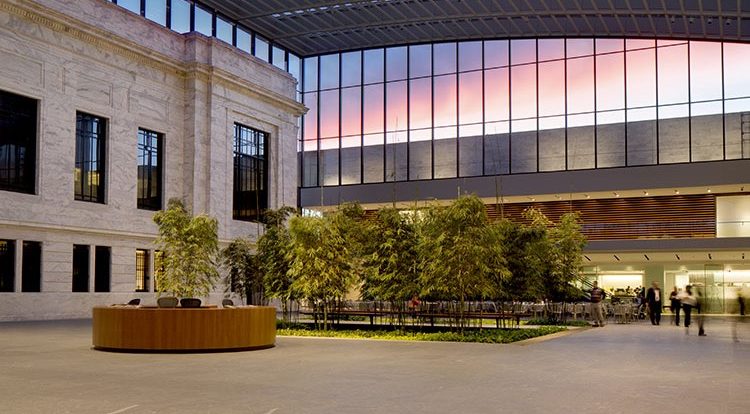Museums and cultural institutions are uniquely positioned to leverage social and sustainability impact strategies to benefit their communities and audiences. These strategies can be incorporated into education programming, help draw increased numbers of visitors, and demonstrate a commitment to environmental responsibility.
Sustainability
Many museums and cultural institutions worldwide have begun taking meaningful steps to reduce embodied carbon by implementing sustainable development strategies and innovative practices. Some art museums are reducing carbon emissions by recycling exhibition sets, extending the length of shows, and scaling back on overseas loans of artworks. For example, the School of the Art Institute of Chicago achieved carbon neutrality in 2020 through continued operational changes, renewable energy credits, and carbon offsets.
At Gilbane, our project teams track and report embodied and operational carbon through Procore, an Embodied Carbon in Construction Calculator (EC3) software, and we are currently partnering with CarbonCure to incorporate carbon removal technologies on some of our projects in the Midwest. Integrating these best practices is a top priority on all our projects and directly reduces carbon emissions.
For museums specifically, prioritizing works in permanent collections and pieces located in neighboring states or countries can also reduce the use of freight transport—one of the primary sources of an exhibition’s carbon emissions. Exhibiting the work of artists who share the same awareness of environmental challenges and utilize found objects in their work can also help reduce consumption and carbon emissions.
When community-based facilities, museums, performing arts, and other cultural institutions consider how they build and operate their facilities, they can help protect their local community and the collections they house.
Social Impact
Museums and cultural institutions play a crucial role in the social fabric of our communities as they contribute to building local identity and provide opportunities for education and creative expression.
There are numerous opportunities to make a social impact, including applying a strategic approach to developing the visitor experience and making decisions through the lens of diversity, equity, and inclusion:
- Visitor Experience – Engaging the community to understand their wants, needs, and viewpoints is critical to delivering the ultimate visitor experience—what do they want to learn about, and what stories do they want to tell? Museums and cultural institutions are more than just repositories for historical objects and works of art–they can serve as community centers or gathering spaces. These facilities have the opportunity to be a reflection of the neighborhoods and people they serve. These facilities have the opportunity to be a reflection of the neighborhoods and people they serve.
In Chicago, we collaborated with the National Museum of Mexican Art (NMMA), Yollocalli Arts Reach students, and the design team to create a stunning video showcasing the proposed design for NMMA’s new youth education center. The video the Gilbane MediaStudio team produced highlights the future expansion of Yollo in a former firehouse where they will continue to expand their programming for students to grow as artists, storytellers, architects, designers, and journalists and become active members of their communities.
Integrating arts into active green spaces in local communities can also foster the visitor experience. For example, The Arts Lawn, which opened in 2023, represents a vibrant green space for the city of Chicago and was designed to contribute to the cultural and economic vibrancy of the local neighborhood. This facility was created in partnership with the local community and reflects the South Side of Chicago. The Arts Lawn will provide equitable access to outdoor community-centered arts programs, including film screenings, live theater and performance, outdoor music, youth education, and arts marketplaces.
- Diversity, Equity, and Inclusion – Museums, performing arts, and other cultural institutions should be accessible to a broad and diverse audience. To diversify the audience, curated experiences must be meaningful for people of various origins and backgrounds. Are you crafting those stories with the input of staff who identify as part of the communities you’re representing? Hiring local and diverse team members and crafting accurate descriptions/messages of the art and artifacts represented will help foster a more diverse and inclusive facility.
At Gilbane, we seek to maximize participation by diverse-owned businesses, including minority-, women-, LGBTQIA+-, and veteran-owned, and to have a diverse, local workforce on our construction projects. We understand that it is our responsibility as builders to apply an economic inclusion lens to all we do, ensuring that our projects are successful and benefit the communities in which we work and live.
Ultimately, museums and cultural institutions help transform and broaden visitors’ perspectives and enhance communities in numerous ways. As many museums and cultural institutions prioritize social and sustainability initiatives, design and construction teams must remain at the forefront of this evolution to ensure these facilities thrive and remain a centerpiece in our local communities.

